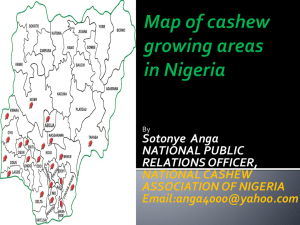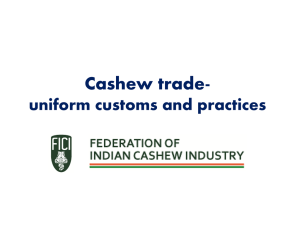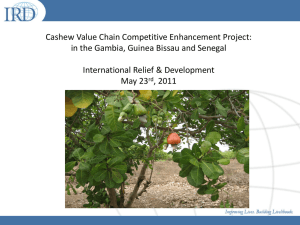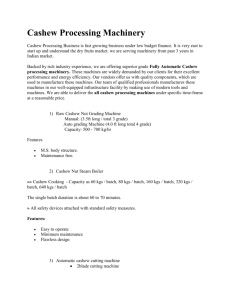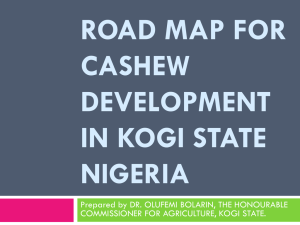Sample Synopsis 1 - TECHePRoSOFT Solutions
advertisement
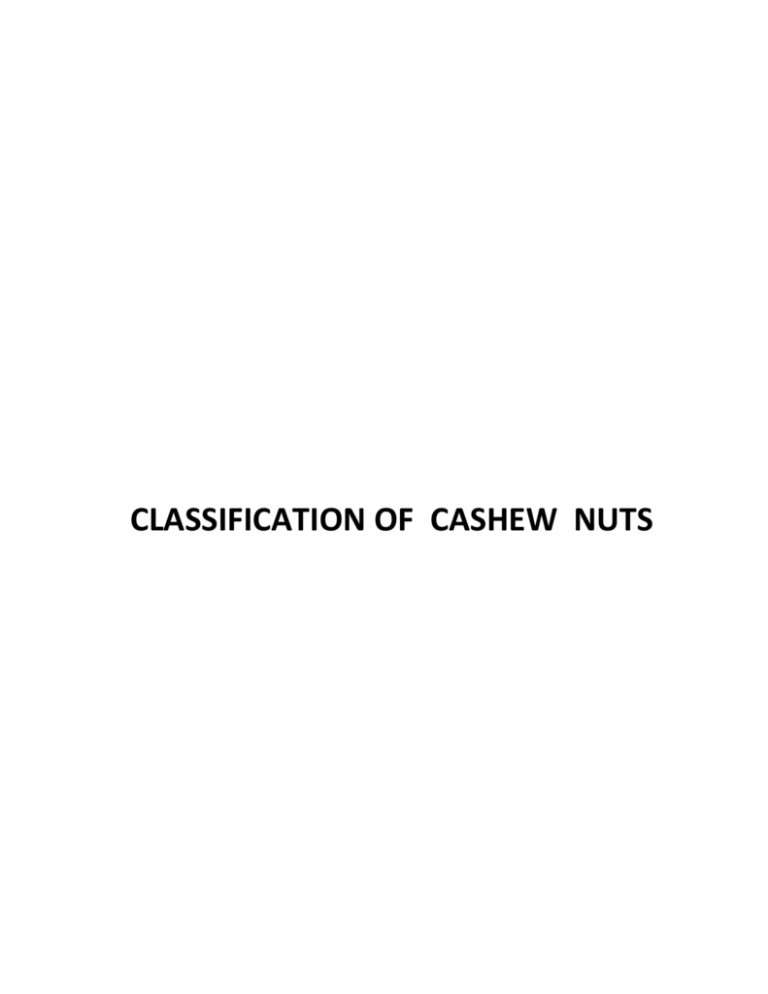
CLASSIFICATION OF CASHEW NUTS
Abstract
Cashew is one of the most popular tree nuts. It is an expensive agricultural product and the prices depend
on its quality. Today, various kinds of cashews are available in the market with different qualities. To
ascertain the quality, grade standard have been designed by considering the color and the size (weight) of
the cashew kernel as important characteristic.
Cashew is a commercial commodity that plays a major role in earning foreign revenue among export
commodities in India. The purpose of this research work is to explore image processing techniques and
approaches on cashew variety identification. The classification system is evaluated based on Naive
Bayes Algorithm cashew. Computer vision has been successfully adopted for the quality analysis of meat
and fish, pizza, cheese, and bread. Likewise grain quality and have been examined by this technique. This
paper presents the significant elements of a computer vision system and emphasizes the important aspects
of the image processing technique coupled with a review of the most recent developments throughout the
food industry.
We will be designing a system which takes physical properties of cashew kernel into consideration. And
it yields better results. Length (L), Width (W) and Thickness (T) of the cashew kernel plays vital role in
deciding the grade of the cashew kernel which are measured. The classification is done using Naïve
Bayes algorithm.
Introduction and Literature Survey
Cashews are most widely grown crop of India especially in coastal areas. In the recent years, Cashew is a
commercial commodity that plays a major role in earning foreign currency among export commodities in India. The
Assessment of cashew quality is the function of government agency entrusted to perform cashew kernel grading and
it is important for the cashew export industry. The grading operation is important, as it is the last opportunity for
quality control on the kernels. With the exception of a few grading aids, all grading is being done by manually. In
the present international market scenario, it is very much essential to keep our products well graded automatically to
compete in the market place. For large operations looking towards export markets, it is necessary to grade the
kernels to an international level. India, the largest exporter & distributor of Cashew Nuts in the world, cashew nuts
are of the highest quality and has helped in gaining repute amongst all in the international market.
To ascertain the quality, grade standard have been designed by considering the color and the size (weight) of the cashew kernel as
important characteristic as shown in Table 1 and Table 2.
The physical properties of the cashew nut is shown below.
From the paper published by Zhang Lin[1],it is cleared that the relationship between length and height of
cashew nuts is linear.This means that for the majority of cashew nuts ,longer the length of cashew nuts
is,higher the height of cashew nuts is. Due to this we can use length as key parameter in cashew
classification.
As from [1], we can divide the cashew nuts into four levels;14mm,14-19mm,19-26mm and 26mm
above. If ‘y’ is height and ‘x’ is length then relation is given by y=0.5x+5.Then we can divide the
cashew nuts based on length as 18mm,18-28mm,28-42mm and 42mm above. The width of cashew
nuts is identified by using standard deviation(or some other statistics) by employing image
processing technique.
Proposed System
We will be developing a Matlab based system .In this we will take image as input,do operations and
classify using Bayes algorithm. The basic development module is shown below.
Cashew nut image
Fig.2.A basic model of classification
We will be using freely available images from internet .In preprocessing,we will be doing resize and
converting the image into gray scale if it is color.
Image segmentation refers to the process of delineating the regions or objects of interest in an image. For
this work, the cashew kernel must be isolated from the background before they could be characterized.
The first step in image analysis is to find objects. For this, object color must be different from colored
foreground, based on a given color threshold set by the user. Thresholding is an important part of image
segmentation. The threshold value is generated according to the results of the histogram analysis and was
constant for the same environment conditions.This results in a black and white (binary) image from the
color image, where background pixels are painted black and objects painted white. The image must retain
the colour information of the cashew kernel when segmentation was processed. All the pixels with
intensity value greater than 35 were assigned the value 255, and all pixels with intensity value less than or
equal to certain threshold e.g.35 were not processed in any operation.
Image features of the cashew kernels were extracted to characterize the physical quality attributes of cashews. A
number of color features were computed and tested. They included the means and standard deviations of R, G, and
B(red,green, and blue); the means of H, S, and I (hue,saturation, and intensity); excess red (2R–G–B),excess green
(2G–R–B), and excess blue (2B–R–G).The excess colors correspond more closely to the way humans perceive
colors than the RGB representation.
The classification is done by using Naïve Bayes algorithm. Naive Bayes is a successful classifier based upon the principle of
Maximum A Posteriori (MAP). Given a problem with K classes {C1, . . . ,CK} with so-called prior probabilities P(C1), . . . ,
P(CK), we can assign the class label c to an unknown example with features x = (x1, . . . , xN) such that c = argmaxcP(C = ckx1,
. . . , xN), that is choose the class with the maximum a posterior probability given the observed data. This aposterior probability
can be formulated, using Bayes theorem, as follows: P(C = ckx1, . . . , xN) = P(C=c)P(x1,...,xNkC=c) P(x1,...,xN). As the
denominator is the same for all classes, it can be dropped from the comparison.
Now, we should compute the so-called class conditional probabilities of the features given the available classes. This
can be quite difficult taking into account the dependencies between features. The naive bayes approach is to assume class
conditional independence i.e. x1, . . . , xN are independent given the class. This simplifies the numerator to be P(C =
c)P(x1kC = c) . . . P(xNkC = c), and then choosing the class c that maximizes this value over all the classes c = 1, . . . ,K.
Clearly this approach is naturally extensible to the case of having more than two classes, and was shown to perform well
in spite of the underlying simplifying assumption of conditional independence.
Our proposed system can be presented as shown below.
Fig.3. A classification model using Bayes theorem
Experimental Results
Input and Output details
Input : cashew image dataset for training and one image for testing
Output: the cashew nut is classified as one of the level and also its grade is displayed. And also
histograms are displayed
Cashew Dataset: any freely available dataset in the internet.
Project Development Details
Tool: Matlab 7.10
Operating System: 32 bit Windows XP(or 7)
RAM: 2GB
Conclusion
There is no universal algorithm for suitable classification of cashew nuts. We will try to classify the nuts
with better accuracy. By using the proposed classification, we can get more accuracy compared to basic
image processing method.
References
1.Zhang Lin,”Research and analysis of classification model based on the shape parameters of cashew
nuts,IEEE-2011.
2. Mayur Thakkar,Malay Bhatt,C. K. Bhensdadia"Performance Evaluation of Classification Techniques
for Computer Vision based Cashew Grading System",International Journal of Computer Applications
(0975 – 8887)Volume 18– No.6, March 2011
3. P.Patel,M. Samvatsar,P. K. Bhanodia,"A Survey Paper On Cashew Kernels Classification Using Color
Features & Computer Revelation System",International Journal Of Engineering Sciences & Research
Technology,Aug-2012.
4. Bay, S., 1998. Combining nearest neighbor classifiers through multiple feature subsets. International
Conference on Machine Learning, 37–45.
5. http://cashewindia.org/
6. http://rawcashewnuts.com/....a Kerala promoted website
